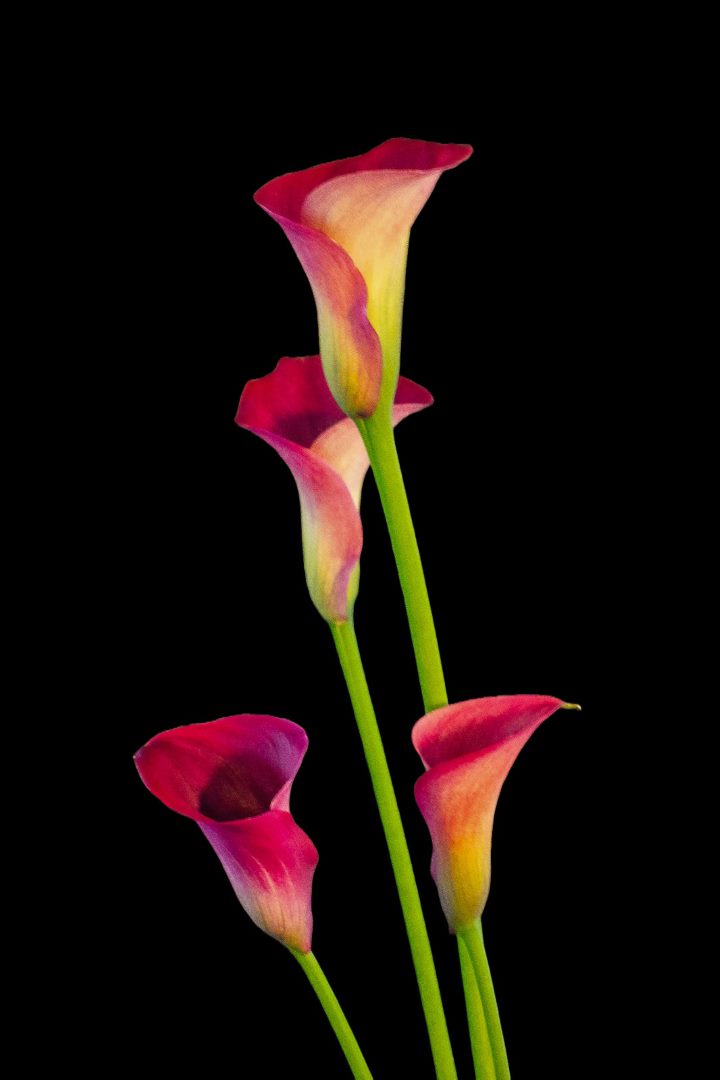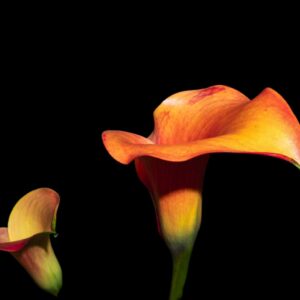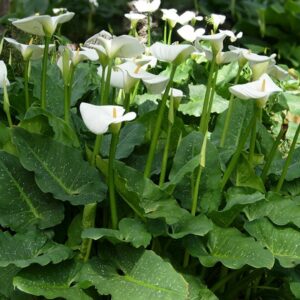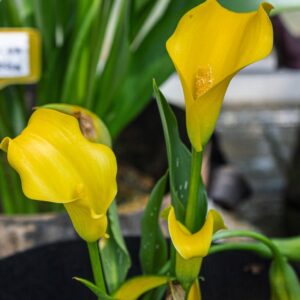Your cart is currently empty!
The Difference Between Arum and Calla Lilies

Even among seasoned gardeners, many people don’t realize that Calla lilies and Arum lilies are not the same plant. Although the two are related and bear a strong resemblance, they differ in some important ways. Understanding these differences can help in determining which is best for your garden. Knowing their specific needs and characteristics will aid in selecting the right lily for your climate and garden conditions, ensuring a thriving and beautiful display.
Taxonomy and Origins
Arum lilies (Zantedeschia aethiopica) and Calla lilies (Zantedeschia elliottiana and Zantedeschia rehmannii) belong to the family Araceae. Arum lilies are native to southern Africa, specifically Lesotho, South Africa, and Eswatini. They are known for their large, white spathes and central yellow spadix. In contrast, Calla lilies, which are also native to southern Africa, include species that are recognized for their vibrant colors, ranging from yellow to pink and purple, and are often found as hybrids in horticultural settings. These species have been introduced worldwide and are popular in ornamental gardening.
Physical Characteristics
Arum Lilies (Zantedeschia aethiopica)
Arum lilies, also known as Zantedeschia aethiopica, are striking perennial plants that can grow up to 1.2 meters tall. They are characterized by their large, arrow-shaped leaves, which are a deep green and can reach lengths of up to 45 cm. The leaves are broad and form clumps that give the plant a lush, full appearance. The most distinctive feature of Arum lilies is their inflorescence, which consists of a white, funnel-shaped spathe surrounding a yellow, finger-like spadix. The spathe, which can be up to 25 cm long, is often mistaken for the flower petal, but it is actually a specialized leaf. The true flowers are tiny and located on the spadix. The inflorescence emits a faint, sweet fragrance, adding to its allure. These plants are typically evergreen in regions with adequate rainfall and temperatures, but they may become deciduous in drier areas.
Arum lilies are also known for their potential to become invasive, particularly in wetlands and riparian zones. They propagate both by seed and vegetative reproduction through rhizomes, which can spread extensively if the conditions are favorable. This characteristic makes them a hardy and sometimes challenging species to manage in garden settings, especially near water bodies.
Calla Lilies (Zantedeschia elliottiana and Zantedeschia rehmannii)
Calla lilies, which include Zantedeschia elliottiana and Zantedeschia rehmannii, are known for their vibrant and varied colors. Unlike Arum lilies, Calla lilies tend to be smaller, growing up to 60 cm tall. Zantedeschia elliottiana, also known as the golden or yellow calla lily, features deep green leaves that are often spotted with white, providing a striking contrast to its bright yellow spathes. These spathes surround a yellow spadix and occasionally produce bright yellow berries that attract birds.
Zantedeschia rehmannii, commonly referred to as the pink or red calla lily, has a spathe that ranges in color from mauve to rose-purple, with paler margins. Its leaves are narrow and lance-shaped, without the spotting seen in other calla species. The plant grows to about 40 cm tall, with leaves that are semi-erect and provide a graceful backdrop to the colorful spathes.
Both types of Calla lilies have a similar inflorescence structure to Arum lilies, with a spathe surrounding a spadix. However, the color variations and smaller size make Calla lilies popular for ornamental gardening and floral arrangements.
Growing Conditions and Care
Ideal Growing Conditions for Arum Lilies
Arum lilies thrive in shady, wet environments, making them well-suited for planting around ponds, marshes, and other areas with consistent moisture. They prefer rich, well-draining soil and can tolerate heavy clay soils as long as they are kept moist. These lilies are hardy and can withstand temperatures as low as -23°C, making them suitable for cooler climates. In areas where they are at risk of becoming invasive, it is important to manage their growth by removing seed heads and controlling their spread through rhizomes.
Ideal Growing Conditions for Calla Lilies
Calla lilies prefer sunny locations with well-draining soil. Unlike Arum lilies, they do not thrive in overly wet conditions and are more suited to garden beds and containers where soil moisture can be controlled. They are less cold-hardy, typically surviving in temperatures down to -12°C. In cooler climates, Calla lilies are often grown as tender bulbs or houseplants to protect them from frost. They benefit from a balanced fertilizer during the growing season to support their vibrant blooms.
Comparison of Hardiness and Environmental Preferences
Arum lilies are more cold-tolerant and can thrive in wetter, shadier environments compared to Calla lilies. Their ability to grow in marshy conditions makes them versatile but also potentially invasive in suitable habitats. Calla lilies, on the other hand, require more sunlight and well-draining soil, making them less adaptable to wet conditions but ideal for garden beds and container planting. Their vibrant color range and smaller size offer more versatility in ornamental gardening, especially in climates where they can be protected from severe cold.
Propagation and Invasiveness
Methods of Propagation for Both Types
Arum Lilies (Zantedeschia aethiopica): Arum lilies propagate through both seeds and vegetative means. The seeds are dispersed by birds and water, which can lead to rapid spread in suitable environments. Vegetative propagation occurs via rhizomes, which are underground stems that produce new shoots. Rhizomes can be divided and transplanted, making this a common method for gardeners. Due to their ability to spread rapidly through rhizome offsets, they can quickly establish dense colonies if not managed properly.
Calla Lilies (Zantedeschia elliottiana and Zantedeschia rehmannii): Calla lilies primarily propagate through tubers, which are swollen underground stems. Tubers can be divided and replanted, and this method is commonly used to propagate new plants. Some species can also propagate through seeds, but this is less common in horticultural practice. The tubers are typically planted in the spring, and they require a period of dormancy during the winter.
Potential for Invasiveness and Ecological Impact of Arum Lilies
Arum lilies have a significant potential for invasiveness, particularly in wet and marshy areas. Their ability to propagate through both seeds and rhizomes allows them to spread quickly. In regions like Western Australia, they have become problematic weeds, outcompeting native vegetation and disrupting local ecosystems. The dense colonies formed by Arum lilies can choke waterways, alter water flow, and negatively impact the biodiversity of wetland habitats. To manage their invasiveness, it is recommended to remove seed heads after flowering and control the spread of rhizomes.
Non-Invasive Nature of Calla Lilies
Calla lilies, in contrast, are less invasive due to their slower rate of propagation and preference for well-drained soils. They do not thrive in the same wet conditions that facilitate the rapid spread of Arum lilies. Additionally, their propagation through tubers means they do not spread as aggressively. As a result, Calla lilies are generally not considered a threat to native ecosystems and are safe to plant in a variety of garden settings without the risk of becoming invasive.
Flowering and Visual Appeal
Description of Flowers, Spathes, and Spadices
Both Arum and Calla lilies produce inflorescences that consist of a spathe and spadix. The spathe is a large, colorful bract that surrounds the spadix, a central spike covered with tiny flowers. In Arum lilies, the spathe is typically pure white and can reach up to 25 cm in length, creating a striking contrast with the yellow spadix. Calla lilies have more diverse spathe colors, including shades of yellow, pink, purple, and even dark maroon, depending on the species and cultivar.
Color Variations and Visual Differences
Arum Lilies:
- Predominantly white spathes, with some varieties exhibiting hints of pink or green.
- The spadix is usually yellow.
- The foliage is large, broad, and deep green, forming a lush backdrop to the inflorescences.
Calla Lilies:
- Wide range of spathe colors, including yellow (Z. elliottiana), pink, and purple (Z. rehmannii).
- Spadices are typically yellow but can vary.
- Leaves are often spotted with white, adding an additional layer of visual interest.
- The smaller size and varied colors of Calla lilies make them versatile for ornamental use in gardens and floral arrangements.
Seasonal Flowering Periods
Arum Lilies:
- Bloom from late winter to late spring.
- In regions with adequate moisture and mild temperatures, they can produce inflorescences multiple times a year.
Calla Lilies:
- Primarily bloom in the summer.
- Flowering periods can extend into late summer, especially in optimal growing conditions with adequate sunlight and well-drained soil.
Understanding these flowering periods can help gardeners plan their garden designs to ensure continuous blooms throughout the growing season, leveraging the unique visual appeal of both Arum and Calla lilies.
Common Uses and Symbolism
Ornamental Uses in Gardens and Landscapes
Arum Lilies (Zantedeschia aethiopica): Arum lilies are a popular choice for ornamental gardening due to their striking appearance and hardiness. Their large, elegant white spathes and lush green foliage make them ideal for creating dramatic displays in gardens. They are often planted around water features such as ponds and streams, where their preference for moist conditions can be fully utilized. In landscaped gardens, they can be used as focal points or planted in clusters to create a mass of white blooms. Arum lilies are also suitable for use in shaded areas where many other flowering plants may struggle to thrive.
Calla Lilies (Zantedeschia elliottiana and Zantedeschia rehmannii): Calla lilies are highly valued for their vibrant colors and versatility in garden design. Their wide range of spathe colors, including yellow, pink, and purple, allows for creative combinations and striking contrasts in flower beds and borders. They are often used in mixed plantings to add a splash of color and can be effectively combined with other perennials and annuals. Calla lilies are also well-suited for container gardening, making them a great option for patios, balconies, and small garden spaces. Their compact size and diverse color palette make them a favorite for cut flower arrangements, providing long-lasting beauty indoors.
Cultural and Symbolic Significance
Arum Lilies: Arum lilies hold significant cultural and symbolic meanings in various contexts. They are often associated with purity, rebirth, and transformation, largely due to their pristine white blooms. In Christian symbolism, Arum lilies are linked to the Virgin Mary and are often used in religious ceremonies and Easter celebrations. They also symbolize sympathy and are commonly used in funeral arrangements to convey condolences and honor the deceased.
Calla Lilies: Calla lilies are symbols of beauty, sophistication, and elegance. Their varied colors each carry specific meanings; for example, white calla lilies represent purity and innocence, while pink signifies admiration and appreciation, and yellow symbolizes gratitude and joy. Calla lilies are frequently used in weddings and other celebratory events due to their association with these positive attributes. In addition to their aesthetic value, they have been featured in numerous works of art and literature, highlighting their timeless appeal and cultural importance.
Potential Issues and Toxicity
Common Pests and Diseases Affecting Each Type
Arum Lilies: Arum lilies are generally robust but can be affected by several pests and diseases. Common pests include aphids, which can cause damage by sucking plant sap and spreading diseases. Slugs and snails are also frequent nuisances, particularly in damp environments. Fungal diseases such as root rot and leaf spot can occur if the soil is overly wet or poorly drained. To manage these issues, it is important to maintain good garden hygiene, provide adequate spacing for air circulation, and use appropriate pest control measures.
Calla Lilies: Calla lilies are similarly susceptible to pests and diseases. Aphids, spider mites, and thrips are common pests that can damage the plants by feeding on their sap. Calla lilies are also prone to fungal infections such as botrytis blight, which causes gray mold on flowers and leaves, and rhizome rot, which can be devastating if the soil is too wet. To prevent these problems, it is essential to ensure proper drainage, avoid overhead watering, and use fungicides when necessary. Regular inspection and prompt removal of affected plant parts can also help in managing pest and disease outbreaks.
Toxicity and Handling Precautions
Both Arum and Calla lilies contain calcium oxalate crystals, which are toxic if ingested. These crystals can cause severe irritation and swelling of the mouth, throat, and digestive tract. Symptoms of poisoning include burning sensations, difficulty swallowing, stomach pain, and vomiting. As a result, it is important to handle these plants with care, especially around children and pets.
When handling Arum and Calla lilies, it is advisable to wear gloves to prevent skin irritation. If any part of the plant is ingested, it is crucial to seek medical attention immediately. Gardeners should also be mindful of disposing of plant material safely to avoid accidental ingestion by animals. Despite their beauty, these lilies require careful handling to ensure safety for both humans and animals.
Conclusion
Summary of Key Differences
Arum lilies (Zantedeschia aethiopica) and Calla lilies (Zantedeschia elliottiana and Zantedeschia rehmannii) are often confused due to their similar appearance, but they have several distinct differences. Arum lilies are taller, more cold-hardy, and prefer wet, shady environments. They have large white spathes and can become invasive. In contrast, Calla lilies are smaller, thrive in sunny, well-drained conditions, and come in a variety of vibrant colors such as yellow, pink, and purple. They are less likely to spread aggressively and are ideal for ornamental use in gardens and containers.
Recommendations for Choosing Between Arum and Calla Lilies for Gardening
When deciding between Arum and Calla lilies for your garden, consider the following:
- Climate: If you live in a cooler climate with the potential for frost, Arum lilies may be a better choice due to their hardiness. Calla lilies are more suited to warmer climates or can be grown as tender bulbs in cooler regions.
- Soil and Moisture: Arum lilies thrive in moist, shady areas and can handle wet soils, making them perfect for planting around water features. Calla lilies prefer well-drained soil and plenty of sunlight, making them suitable for garden beds and containers.
- Invasiveness: If you are concerned about invasive species, particularly near water bodies, Calla lilies are a safer choice. Arum lilies can become invasive and require management to prevent their spread.
- Aesthetic Preferences: For a dramatic, elegant look with large white blooms, Arum lilies are ideal. For a burst of color and more compact growth, Calla lilies offer a variety of hues and are excellent for creating vibrant displays in gardens and floral arrangements.
By considering these factors, you can choose the lily that best fits your garden’s conditions and your personal preferences.








Leave a Reply